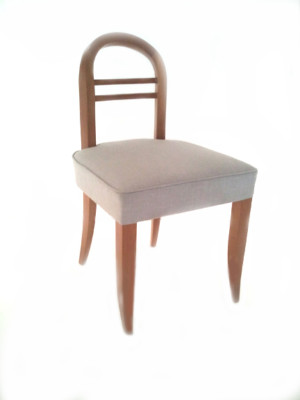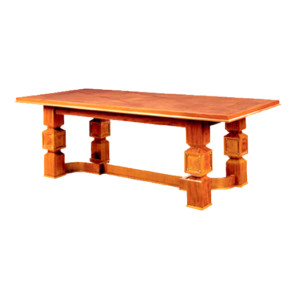June 20, 1906 – January 16, 1993
It is interesting to note that artistic talent often manifests itself at an early age. Lucien Rollin is a perfect example – he was admitted to the famed and prestigious École Boulle, the finest training school for furniture design and production in France in 1919, at the tender age of thirteen. In France at this time, it was not unusual for a young man to begin training in a trade rather than continue on to a formal academic education. This produced many highly trained designers and craftspeople who were masters of their trade by the time they were 20.
Rollin graduated from the École Boulle, which was then under the direction of the highly influential André Fréchet, in 1923. Upon his graduation, he began working for Jacques-Emile Ruhlmann, who was arguably the most important designer of his time, known for his ultra-luxe furnishings. At first, he worked for Ruhlmann as a draftsman, and helped with the preparation of the Hotel du Collectioneur – Ruhlmann’s great contribution to the 1925 International Exposition of Modern Decorative and Industrial Arts, from which the term Art Deco was derived.
With his career already off to an auspicious beginning, Rollin, at age 19, entered the renowned École des beaux arts in Paris. He not only wanted to further his skills, but also wanted to work with the highly respected architect and designer Michel Roux-Spitz. By 1928, he felt confident enough to establish his own design workshop and show room on the rue des Perchamps.
Rollin began showing his ensembles of furniture, rugs and lighting each year at the Salons des Artistes Décorateurs. After 1928, he was so respected that his entries were exempted from jury judging, and he became a permanent Member of the Société.
Rollin’s interest was as much in architecture as in furniture design. While his training up to this point had been thoroughly French, he was very conversant with and a great admirer of the work of the famed American Frank Lloyd Wright. Rollin recognized that American design was not as beholden to the past as French tradition was, and admired Wright’s originality and creative freedom. He was also aware of the very new designs using steel and glass, and wanted to incorporate these various materials into his work to create a very modern style. He actually traveled to the United States in 1932 to meet Frank Lloyd Wright and explore cabinet-making techniques in the US. He would eventually go on to do quite a lot of important design work in America.
Back in Paris, Lucien designed some beautiful pieces for the International Exhibition of Modern Decorative and Industrial Arts. He loved rare and unusual woods, and made eloquent use of amboina, macassar ebony, palisander, amboina, zebra wood, and Cuban mahogany. He realized that by deftly using the fascinating grains and textures of these rare woods, either alone or in various combinations, some involving elaborate marquetry work, he could focus on perfect lines and proportions, and not have to rely on ornamentation to create pieces that were luxurious and beautiful, although he did occasionally call upon Gilbert Poillerat, a friend and famous in his own right to contribute beautiful metal embellishments to certain of his pieces.
Rollin returned to the US in 1933, under the auspices of the French Government, to attend the Century of Progress Exhibition in Chicago, so that he could study American architecture and design towards participating in the Paris Exhibition of 1937. While in the US, he was invited by W&J Sloane, the highly prestigious purveyors of fine rugs and furniture in New York City and acknowledged tastemakers for many wealthy Americans. Rollin designed a modern apartment for show in their 5thAvenue galleries. Back in France, his reputation continued to grow. In 1933, Rollin received the highest award (gold medal) at the Salon des Artistes Décorateurs from the French Président Lebrun.
Rollin designed staterooms for the famed liner Normandie, and received two major awards (one of which was the highest prize) at the International Exhibition of Brussels. He created a monumental table for the City Hall in Aubusson, a city where he spent a good deal of time, and was commissioned by the prestigious Mobilier National to design furniture for the Elysée Palace, and for the French Embassy in Brussels. He also designed a living room, completed in 1946, for General Delattre de Tassigny’s office in the Hôtel des Invalides which is still in use.
Rollin’s interpretations of Post Modern design were elegant and timeless. By 1937, he was showing his work at the Marshall Fields Gallery in Chicago, and was called upon to redesign the interior and furniture of the Bullock’s Wilshire Building in Los Angeles. Rollin also had several rooms in the French Pavillion of the 1939 New York World’s Fair.
Rollin, however, was not working in a vacuum. He was surrounded by other gifted and prominent designers, among them Jean-Jacques Adnet, Andre Arbus and Jean-Charles Moreux, and perhaps because of their influence, returned briefly to more “traditional” French design. Finally, however, Rollin found this return to the past not to his taste, and decided to devote himself to architecture, and worked as an architect into the 1980’s. He retired to the south of France, where he died on January 16, 1993.
Showing all 2 results



